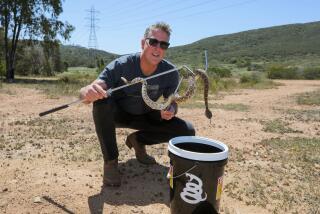Canada: Snakes alive! This Manitoba mating dance mesmerizes
- Share via
An annual spring ritual draws curiosity-seekers -- those not afraid of serpents--to the plains of central Manitoba, Canada, where the arrival of warmer weather brings with it mating season for scads of snakes.
Conservation Manitoba, a government agency, boasts that at Narcisse Snake Dens “you can see more snakes at a glance than anywhere else in the world.” Each spring, tens of thousands of non-poisonous, red-sided garter snakes emerge from their subterranean winter homes to bask on the balmy plains and reproduce.
The mating dance -- it’s more of a slither -- is quite the spectacle, and a lopsided one too. For every female, there are 5,000 males, which means the sparse females are covered by males seeking an opportunity to hook up. The garter snakes are so preoccupied that they ignore human interlopers.
There’s no real harm in picking up the slithering reptiles, which will likely wrap themselves around a warm, outstretched arm. Travel Manitoba says they may bite, but it’s just a nip. After handling the snakes, you’ll need to wash up because the scent the snakes leave behind isn’t pleasant. There are pumps and outhouses on site.
The courting season is a short one. Within two or three weeks of emerging from their winter dens, the fertilized females move on to nearby marshes to spend the summer and hatch their eggs. The snakes won’t congregate in such masses again until fall, when cooling temperatures tell them it’s time to return to the limestone bedrock, sheltered from the frozen surface.
This year, spring has been late to arrive in Manitoba. That means it will probably be mid-May before the frenzy gets underway. Updates on the snakes’ movements can be found online at both the government website and one maintained by NatureNorth, an online nature magazine.
Narcisse is about an hour-and-a-half drive north from Winnipeg. The snake dens, which are signposted, are about four miles out of town along Highway 17. A 1.8-mile-long trail of crushed limestone trails winds through the native grasslands past four dens. There are interpretive signs along the way.
Follow us on Twitter @latimestravel and like us on Facebook.
More to Read
Sign up for The Wild
We’ll help you find the best places to hike, bike and run, as well as the perfect silent spots for meditation and yoga.
You may occasionally receive promotional content from the Los Angeles Times.






